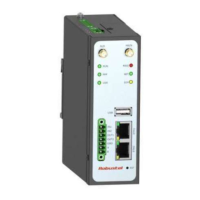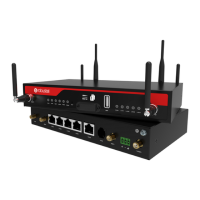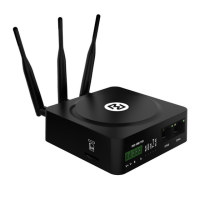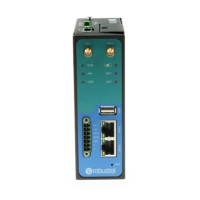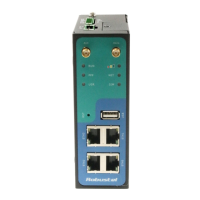
Do you have a question about the Robustel GoRugged R2000 and is the answer not in the manual?
| Model | GoRugged R2000 |
|---|---|
| Category | Network Router |
| Ethernet Ports | 2 x 10/100 Mbps |
| SIM Slots | 2 |
| Power Supply | 9-36 VDC |
| USB Port | 1 x USB 2.0 |
| Cellular Connectivity | 4G LTE, 3G |
| VPN Support | IPsec, OpenVPN, GRE |
| Operating Temperature | -40°C to +75°C |
| WiFi | 802.11 b/g/n |
| Serial Interface | RS232/RS485 |
| GPS | Yes |
| Firewall | SPI Firewall |
| Digital Input/Output | 2 x DI |
Safety guidelines for RF, usage locations, and antenna placement.
Guidelines for installing and operating the router within a vehicle.
Precautions to prevent damage and maintain router integrity.
Lists European directives like RoHS and WEEE relevant to the product.
Details Chinese standards for hazardous substances in electronic products.
Introduces the R2000 as an enterprise-class cellular router for M2M applications.
Lists the items included in the R2000 router package.
Details the technical specifications of the R2000 router's interfaces and components.
Provides physical dimensions and mounting information for the R2000 router.
Lists available R2000 model numbers and their frequency band support.
Describes the R2000 router's ports and SIM card slots.
Explains the function and status of the router's LED indicators.
Details how to use the reset button for rebooting or factory reset.
Describes the router's Ethernet ports and their link indicators.
Provides instructions for inserting and removing SIM cards.
Guides on connecting the external antenna to the router.
Explains the importance of grounding the router for EMI reduction.
Details methods for mounting the router on a wall or DIN-rail.
Explains how to connect the power supply to the router.
Steps to configure a PC's IP address for router access.
Lists default credentials and IP addresses for router login.
Instructions on how to access and log into the router's web interface.
Overview of the router's web interface control panel buttons and functions.
Shows general system details like model, firmware, and uptime.
Displays status of the cellular modem, SIM, and network registration.
Shows WAN link status, uptime, IP address, gateway, and DNS.
Displays IP address and MAC address for the LAN interface.
Manages primary, backup links, and backup modes for connectivity.
Configures LAN interface settings, including IP address and DHCP server.
Configures Ethernet port assignment to LAN interfaces.
Sets up cellular SIM card parameters and network type.
Configures the router as a WiFi Access Point (AP).
Configures the router as a WiFi Client to connect to an AP.
Allows setting up static routes for network traffic.
Configures firewall rules, port mapping, and DMZ settings.
Sets up and configures IPSec VPN tunnels for secure connections.
Configures OpenVPN tunnels for secure remote access.
Configures GRE tunnels for encapsulating network traffic.
Configures syslog settings for logging events and debugging.
Configures event notification settings, including SMS and NVM saving.
Configures Network Time Protocol settings for time synchronization.
Configures SMS management for remote control and authentication.
Configures Dynamic DNS service for aliasing dynamic IP addresses.
Configures Virtual Router Redundancy Protocol for backup routers.
Configures Secure Shell (SSH) access for secure router management.
Configures Robustlink for M2M management platform integration.
Configures HTTP/HTTPS server settings and certificate management.
Configures SNMP agent and trap settings for network monitoring.
Configures advanced settings like device name, periodic reboot, and AT over Telnet.
Checks and downloads syslog details and system diagnostic data.
Instructions for updating the router's firmware.
Manages and installs new functions as APP files on the router.
Provides diagnostic tools like Ping, Traceroute, and Sniffer.
Imports/exports configuration files and restores factory defaults.
Enables/disables WAN interface and configures WiFi mode.
Manages user accounts for router access and permissions.
Steps to configure primary and backup SIM cards for dial-up.
Demonstrates using SMS commands for router status and parameter changes.
Configuration example for setting up an IPSec VPN tunnel.
Configuration example for setting up OpenVPN tunnels.
Configuration example for setting up GRE tunnels.
Explains the Command Line Interface for router parameter configuration.
Provides tips and examples for using CLI commands effectively.
Lists CLI commands, their syntax, and descriptions.


